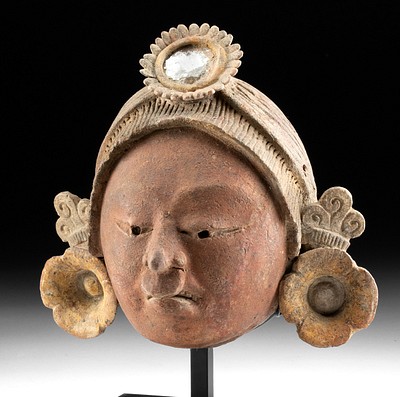20th C. African Mossi Wood Nude Female / Ninana
Lot 148
About Seller
Artemis Gallery
686 S Taylor Ave, Ste 106
Louisville, CO 80027
United States
Selling antiquities, ancient and ethnographic art online since 1993, Artemis Gallery specializes in Classical Antiquities (Egyptian, Greek, Roman, Near Eastern), Asian, Pre-Columbian, African / Tribal / Oceanographic art. Our extensive inventory includes pottery, stone, metal, wood, glass and textil...Read more
Estimate:
$2,000 - $3,000
Absentee vs Live bid
Two ways to bid:
- Leave a max absentee bid and the platform will bid on your behalf up to your maximum bid during the live auction.
- Bid live during the auction and your bids will be submitted real-time to the auctioneer.
Bid Increments
| Price | Bid Increment |
|---|---|
| $0 | $25 |
| $300 | $50 |
| $1,000 | $100 |
| $2,000 | $250 |
| $5,000 | $500 |
| $10,000 | $1,000 |
| $20,000 | $2,500 |
| $50,000 | $5,000 |
| $100,000 | $10,000 |
| $200,000 | $20,000 |
About Auction
By Artemis Gallery
Jul 14, 2022
Set Reminder
2022-07-14 10:00:00
2022-07-14 10:00:00
America/New_York
Bidsquare
Bidsquare : Exceptional Antiquities Ethnographica Fine Art
https://www.bidsquare.com/auctions/artemis-gallery/exceptional-antiquities-ethnographica-fine-art-9692
Museum-worthy examples of classical antiquities (Egyptian, Greek, Roman, Near Eastern), Viking, Far East / Asian, Pre-Columbian, African / Tribal, Oceanic, Native American, Spanish Colonial, Fossils, Ancient Jewelry, Fine / Visual Arts, so much more! Artemis Gallery info@artemisgallery.com
Museum-worthy examples of classical antiquities (Egyptian, Greek, Roman, Near Eastern), Viking, Far East / Asian, Pre-Columbian, African / Tribal, Oceanic, Native American, Spanish Colonial, Fossils, Ancient Jewelry, Fine / Visual Arts, so much more! Artemis Gallery info@artemisgallery.com
- Lot Description
West Africa, Burkina Faso, Mossi peoples, ca. early 20th century CE. A hand-carved wooden female figure known as a ninana standing nude atop broad feet and conjoined ankles. Covered in red pigment, the dark wood figure presents with delineated legs, a slightly distended abdomen above an incised waistline and revealed sex, a pair of lengthy arms flanking a pair of pendulous breasts, and several necklaces incised atop her clavicle. Her ovoid head exhibits serene, downcast eyes, a triangular nose, thin lips curled into a smile, and earlobes adorned with inserted iron wire earrings, all beneath an intricately incised coiffure bearing a herringbone pattern. An oval of black pigment encircles her face and is perhaps indicative of ritual tattooing or scarification. Size: 4.75" W x 14.2" H (12.1 cm x 36.1 cm); 15.375" H (39.1 cm) on included custom stand.
An agricultural community, the Mossi inhabit the central plateau region of Burkina Faso and were developed in the 15th and 16th centuries when the local population intermarried with invading horsemen from northern Ghana. Those descended from the invaders, known as Nakomse, assumed political power over the original inhabitants and became the elite of Mossi society. According to the Smithsonian National Museum of African Art, "Figures of this sort were displayed in public at annual sacrifices honoring the ancestors and then stored in the residence of the chief's senior wife. While on view, the figures were dressed with a cloth wrapper covering the lower portions of their bodies in imitation of Mossi women's traditional dress… The use of sculpture parallels the divisions in Mossi society. Masks are employed exclusively by Tengabisi groups to propitiate and manipulate spirits for the good of the community. Figures, usually female, are reserved exclusively for the ruling elite, the Nakomse, as symbols of political power."
Cf. The Brooklyn Museum, accession number 76.20.5
Provenance: private New York, New York, USA collection; ex-Merton Simpson collection, New York, USA
All items legal to buy/sell under U.S. Statute covering cultural patrimony Code 2600, CHAPTER 14, and are guaranteed to be as described or your money back.
A Certificate of Authenticity will accompany all winning bids.
PLEASE NOTE: Due to recent increases of shipments being seized by Australian & German customs (even for items with pre-UNESCO provenance), we will no longer ship most antiquities and ancient Chinese art to Australia & Germany. For categories of items that are acceptable to ship to Australia or Germany, please contact us directly or work with your local customs brokerage firm.
Display stands not described as included/custom in the item description are for photography purposes only and will not be included with the item upon shipping.
#172631Repair to front of left foot, and loss to front of right foot as shown. Several stable hairline fissures, with light encrustations, fading to red and black pigment, and softening to some finer details. Nice remains of pigment throughout.Condition
- Shipping Info
-
All shipping is handled in-house for your convenience. Your invoice from Artemis Gallery will include shipping calculation instructions. If in doubt, please inquire BEFORE bidding for estimated shipping costs for individual items.
-
- Buyer's Premium



 EUR
EUR CAD
CAD AUD
AUD GBP
GBP MXN
MXN HKD
HKD CNY
CNY MYR
MYR SEK
SEK SGD
SGD CHF
CHF THB
THB













